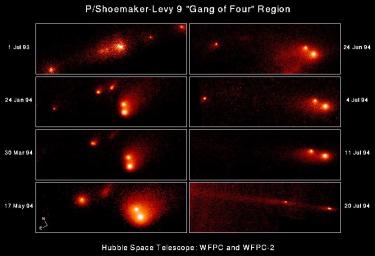
|
Evolution of the P/Shoemaker-Levy 9 “Gang of Four” Region
- Click the image above for a larger view
- Full-Res JPEG (830 x 568) (69.5 kB)
- Full-Res TIFF (830 x 568) (543.5 kB)
Caption:
This series of eight NASA Hubble Space Telescope "snapshots" shows the evolution of the P-Q complex, also called the "gang of four" region, of comet P/Shoemaker-Levy 9.
The eight individual frames chronicle changes in the comet during the 12 months before colliding with Jupiter. The sequence shows that the relative separations of the various cometary fragments, thought to range in size from about 500 meters to almost 4 km (2.5 miles) across, changed dramatically over this period. The apparent separation of Q1 and Q2 was only about 1100 kilometers (680 miles) on 1 July 1993 and increased to 28,000 kilometers (17,400 miles) by 20 July 1994.
The P-Q complex demonstrates that further fragmentation occurred after the breakup of the parent body in July 1992. Fragments Q1 and Q2 were probably together at some point in a single body. However, it is not clear how P1 and P2, and the P and Q objects are related.
Between 24 January and 30 March 1994, the P2 nucleus broke-up into two separate fragments, one of which disappeared by late June. (It might be present in the mid-May image.) The P1 nucleus had a "streaked" appearance on 24 January 1994 and then became a barely discernible "puff" through mid-May. It was not detected in subsequent observations.
Throughout the period, most nuclei were within a 4000 kilometer-wide (2500 miles) spherical cloud of dust, called a coma. However, shortly before impact, the coma around each nucleus became highly elongated along the comet's travel path due to "stretching" by Jupiter's rapidly increasing gravity.
This stretching is dramatic in the image of the Q-complex taken on 20 July 1994, just 10 hours before collision. Despite the coma's changes, HST images show that the core of each nucleus always remained concentrated. This shows that the nuclei were probably not catastrophically fragmenting, at least not up to 10 hours before impact.
The first HST image was taken on 1 July 1993 with the Planetary Camera before the December 1993 HST servicing mission. All other images were taken with the WFPC-2. (The image taken on 17 May 1994 was taken in "wide-field" mode and has a lower resolution than the other WFPC-2 images). The images were taken in visible light. The different shades of red are a false-color representation of the different intensities of light reflecting off the comet's dust. Each frame covers a region 90,000 by 30,000 kilometers (56,000 by 18,600 miles).
Background Info:
This image and other images and data received from the Hubble Space Telescope are posted on the World Wide Web on the Space Telescope Science Institute home page at URL http://oposite.stsci.edu/ .
Cataloging Keywords:
| Name | Value | Additional Values |
|---|---|---|
| Target | Jupiter | Shoemaker-Levy 9 |
| System | Jupiter | |
| Target Type | Planet | Comet |
| Mission | Hubble Space Telescope (HST) | |
| Instrument Host | Hubble Space Telescope | |
| Host Type | Space Telescope | |
| Instrument | Wide Field/Planetary Camera 2 (WFPC2) | |
| Detector | ||
| Extra Keywords | Collision, Color, Dust, Impact | |
| Acquisition Date | ||
| Release Date | 1998-05-02 | |
| Date in Caption | 1993-07-01 | 1994-01-24, 1994-03-30, 1994-05-17, 1994-07-20 |
| Image Credit | JPL/NASA/STScI | |
| Source | photojournal.jpl.nasa.gov/catalog/PIA01264 | |
| Identifier | PIA01264 | |
